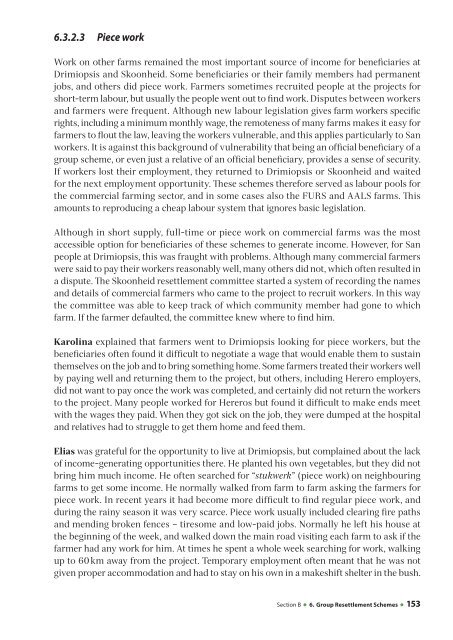Namibia country report
Namibia country report
Namibia country report
- No tags were found...
You also want an ePaper? Increase the reach of your titles
YUMPU automatically turns print PDFs into web optimized ePapers that Google loves.
6.3.2.3 Piece workWork on other farms remained the most important source of income for beneficiaries atDrimiopsis and Skoonheid. Some beneficiaries or their family members had permanentjobs, and others did piece work. Farmers sometimes recruited people at the projects forshort-term labour, but usually the people went out to find work. Disputes between workersand farmers were frequent. Although new labour legislation gives farm workers specificrights, including a minimum monthly wage, the remoteness of many farms makes it easy forfarmers to flout the law, leaving the workers vulnerable, and this applies particularly to Sanworkers. It is against this background of vulnerability that being an official beneficiary of agroup scheme, or even just a relative of an official beneficiary, provides a sense of security.If workers lost their employment, they returned to Drimiopsis or Skoonheid and waitedfor the next employment opportunity. These schemes therefore served as labour pools forthe commercial farming sector, and in some cases also the FURS and AALS farms. Thisamounts to reproducing a cheap labour system that ignores basic legislation.Although in short supply, full-time or piece work on commercial farms was the mostaccessible option for beneficiaries of these schemes to generate income. However, for Sanpeople at Drimiopsis, this was fraught with problems. Although many commercial farmerswere said to pay their workers reasonably well, many others did not, which often resulted ina dispute. The Skoonheid resettlement committee started a system of recording the namesand details of commercial farmers who came to the project to recruit workers. In this waythe committee was able to keep track of which community member had gone to whichfarm. If the farmer defaulted, the committee knew where to find him.Karolina explained that farmers went to Drimiopsis looking for piece workers, but thebeneficiaries often found it difficult to negotiate a wage that would enable them to sustainthemselves on the job and to bring something home. Some farmers treated their workers wellby paying well and returning them to the project, but others, including Herero employers,did not want to pay once the work was completed, and certainly did not return the workersto the project. Many people worked for Hereros but found it difficult to make ends meetwith the wages they paid. When they got sick on the job, they were dumped at the hospitaland relatives had to struggle to get them home and feed them.Elias was grateful for the opportunity to live at Drimiopsis, but complained about the lackof income-generating opportunities there. He planted his own vegetables, but they did notbring him much income. He often searched for “stukwerk” (piece work) on neighbouringfarms to get some income. He normally walked from farm to farm asking the farmers forpiece work. In recent years it had become more difficult to find regular piece work, andduring the rainy season it was very scarce. Piece work usually included clearing fire pathsand mending broken fences – tiresome and low-paid jobs. Normally he left his house atthe beginning of the week, and walked down the main road visiting each farm to ask if thefarmer had any work for him. At times he spent a whole week searching for work, walkingup to 60 km away from the project. Temporary employment often meant that he was notgiven proper accommodation and had to stay on his own in a makeshift shelter in the bush.Livelihoods after Section Land Reform: B ● 6. Group <strong>Namibia</strong> Resettlement <strong>country</strong> <strong>report</strong> Schemes (2010) ● 153
















